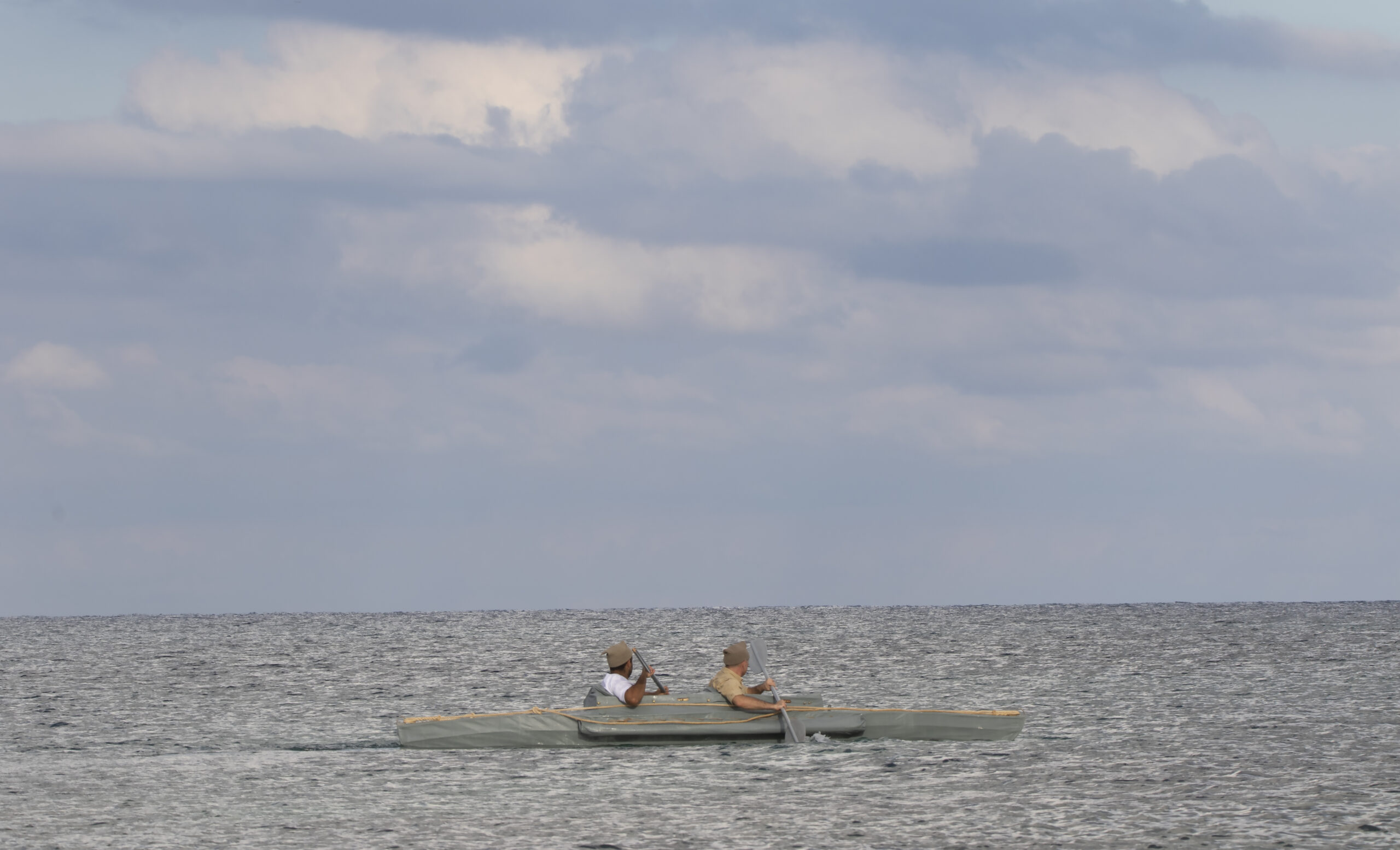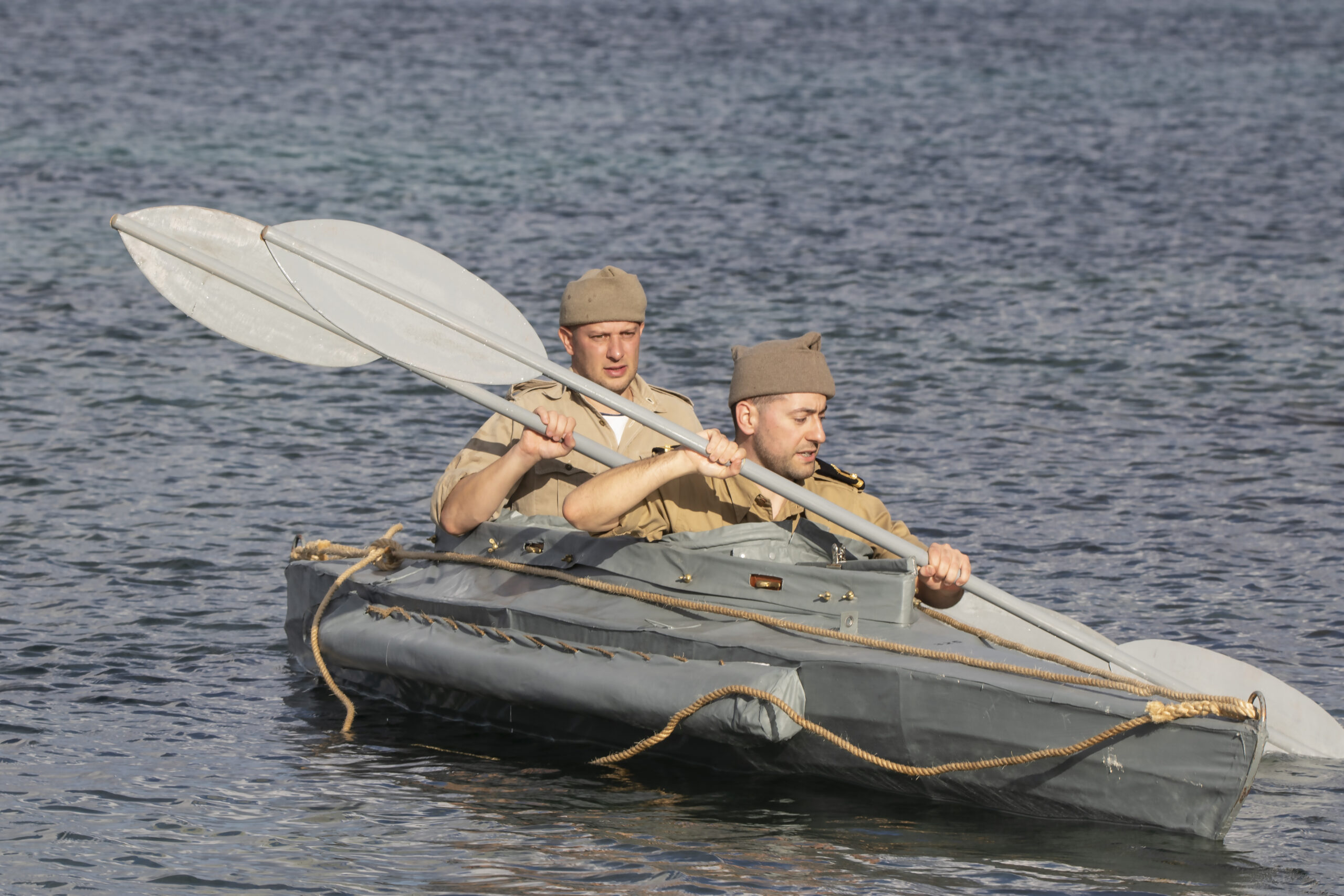Training and ‘Folbot’ canoe
Conditioning of personnel
Both officers and other ranks in COPP had to undergo rigorous practical and theoretical training programs, some of which lasted for a few days, but with a lot to be learned. Since time was of the essence for COPP to be deployed into the field, some of the physical training had to be continued at the placed in which COPP groups were deployed, besides that carried out at Sandy Point.
One of the most important training process was to condition the men of COPP to be properly trained in utilizing the ‘folbot’ canoe (will be discussed in greater detail below) by learning to load it into a British submarine (via the forward torpedo hatch) and then unload it from the submarine, to be able to paddle close to the beach which is to be reconnoitered. Handling and manning the folbot canoe required skill and days of training; men were asked to paddle long distances to get hold of their new watercraft and also learn how to embark and disembark the canoe (especially since all COPP missions took place during night time). On the 24th of February 1943, Willmot specified on paper that the following training list has to be carried out by all COPP personnel:
- Combined operations
- Landing parties pilotage capabilities
- Secret navigational radio aids
- Beach gradient and tide limitations of landing craft and ships
- Submarine periscope work (for reconnaissance purposes from a submarine)
- Launching canoes from submarines
- Sketching (for creating survey maps)
- Photographic interpretation
- Beach organization (naval and military)
- Beach seamanship
- Canoe and swim surveying
- Fin swimming
- Physical hardening
- Stalking and close-combat commando training
- Invasion obstacles and how to overcome them
- Strategic planning and intelligence
- Forms of reconnaissance reporting
- Military considerations and hydrographic and topographical work
- General staff organization
Nigel Wilmott has been quoted as saying:
”it took three months to train a COPP commanding officer (designated the term S/COPP for secrecy purposes) who was already a navigator and five months to train one who wasn’t”.
All operational officers in COPP groups had to learn: scouting and stalking skills, extreme physical endurance training and emergency evasion and survival skills, in case of emergency situations. Above all, officers were also required to know all combined operations staff needs; from topics like strategic planning to matters detailing: lading craft type and navigation, beachmasters and naval commandos and all military aspects related to naval and RAF amphibious landings. Army officers, usually Royal Engineers (designated the term E/COPP for secrecy purposes), did less seamanship and navigation than the naval counterparts, however were expected to do a mine-clearance course and impart that expertise to the rest of COPP. All officers were grouped to be trained together, and once the training was finalized, other ranks and ratings were assigned to a COPP party/group. Besides training at Sandy point, Achnacarry training center and HMS Armadillo training school at Ardentinney was also utilized for most of the commandos training. Eight days were spent learning aspects of beach commandos, beach signals organization and the RAF regiment detail requirements.
For the ratings and other ranks most of the training had to cover knowledge related to that of officers since these had to work had-in-hand during missions of reconnaissance. Any soldiers fresh from commando depots were assigned three weeks SBS training. Semen require naval beach commando training for four weeks at HMS Armadillo. Any personnel assigned maintenance roles were provided training in canoe repairs (possibly being sent to the canoe supplier at the time), radio navigational aids and rubberized swim-suit repairs (will be discussed in detail further on).
The training progress of COPP by the end of 1942 and beginning of 1943, stood as follows:
- COPP 1 was training at Hayling island.
- COPP 2 was a special all naval team bases in the English channel, under the command of Lt H M F Berncastle.
- COPP 3 was in Malta, under the command of Lt N M J Teacher.
- COPP 4 was in Algiers under the command of Lt N McHarg.
- COPP 5, 6 and 7 were undergoing training at Hayling island.
- COPP 8, 9 and 10 were in the process of completing training (finalized in Jun 1943).
What was expected from the officers and other ranks of COPP, once training was finalized and parties assigned to a mission? The following points provide the ideal flow of events once COPP parties became operational:
- Assembled folbot canoe is to be loaded through the forward torpedo hatch of the submarine.
- The designated submarine sails to the planned drop zone with the COPP team. At this point periscope beach reconnaissance might be carried out by a COPP officer (during daylight). Once nightfall approaches the COPP team prepares the equipment to commence disembarking the submarine.
- Submarine surfaces, canoe is unloaded via the forward torpedo hatch and the COPP crew boards the canoe (total of two cockpits). In principal COPP canoes were expected to operate in pairs, naval personnel doing sea reconnaissance and army personnel doing onshore military reconnaissance, however this was not always the case. The submarine would then be trimmed low in water so the canoe floats off its free-flooding case.
- The COPP team would then paddle towards the target beach, stopping about 2 miles from the beach. The crew checks the surroundings and location for any enemy activity and that their position is correct.
- The naval or army officer disembarks the canoe and swims ashore to conduct beach surveying (which usually took 3-4 hours). At the same point in time the paddler/seaman would drop anchor and await the officer’s return. In some cases (especially later in the war) the person that remains in the canoe behind might also be asked to carry other tasks related to beach reconnaissance.
- After the officer (hopefully) returns back to the canoe (making sure to remember the anchored position of the canoe and through the use of low profile signaling equipment), both crew members signal the awaiting submarine to pick them up and return to base with the vital beach reconnaissance information.
The ideal conditions for these missions was a calm sea with minor short lumpy waves and clear skies with no moon, however exceptions had to be made depending on the urgency of the information requested for beach surveying and the time available. Weather conditions were sometimes unpredictable and couldn’t be controlled according to military needs; COPP teams would never operate in bad or stormy weather as this would have definitely jeaopardised the team and the mission.
What could have gone wrong during a reconnaissance mission ?
- Enemy sea or coastal patrol could discover your position or capture team members during beach surveying.
- Sudden changes in wind patterns could generate sea waves which could turn over the canoe and crew drowning.
- Deviating off track from the target beach when paddling in-shore or even loose track when returning back to the anchored canoe.
- Equipment loss or damage.
- Loosing rendezvous point with your submarine, for pick-up and ending up stranded in the middle of nowhere.
- Anything could gone wrong at night! poor vision and care not to give away your position with any signaling equipment or unwanted noises.
More details on Equipment and COPP endeavors in the Mediterranean sea, which supplement the above information, can be found on page 3 and 4.
The folbot canoe
The ‘folbot’ canoe was a skin boat, which was folded up an could be carried around. It was a German design with a very well-thought out plan for use, however it’s production was often poorly executed by some British canoe manufacturers. The structure of the canoe was covered with a rubberized fabric skin and stretched over a wooden frame; it could be dismantled and packed into three large kitbags. Although it seemed practical for use, it didn’t meet COPP’s requirements since it took time to assemble and pass through the forward torpedo hatch of a submarine (also this had to be done at night). Other disadvantages were that it could not be dragged over a beach without the skin tearing, frame and rubber had poor rigidity and could not carry a high payload of equipment required during the reconnaissance missions.
Willmott’s first source for this model of canoe was to obtain a pre-war commercially marketed folbot. At the time (pre-war) the company producing the folbot canoes was Folboat Folding Boat Ltd. On the 20th of November 1940, the company promised delivery but a year later they reported that they were going out of business. In the same month Brigadier J C Haydon from the HQ special Service Brigade reported that an excellent folbot might be obtained from Tyne Folding boats, Richmond on Thames. Goately and Cowes were also recommended as being able to produce the craft. On the 29th July 1941 an order was signed for thirty folbots. Some of the manufacturers found it difficult to source materials for the proper production of the canoe or did not have enough resources/manpower to provide the requested numbers. In any case the latter types of canoe was a two-seater, sports canoe which was built for calm seas, lakes, river and inland waterways; windy weather or choppy seas could easily turn over the canoe or jeopardize the safety of it’s paddlers. A folbot model was required for open seas use and also made of rigid material to serve it’s purpose; Willmott had to consult other possible suppliers and naval departments to ask for logistical assistance.
In despair at the lack of understanding from the admiralty, with regards to fabrics for the canoe and other important operational matters, Willmott decided to consult the Ministry of Air production (MAP) to try and source the desired materials and initiate proper supply of folbot canoes to his COPP’s. It was thanks to Squadron Leader P. Levy from the MAP that assisting Willmott, linking him up with Mr. Harris Lebus (English furniture manufacturer), sparking up the construction of a unique watercraft for COPP use, the Mk1** folbot canoe! The Mk1** name was assigned to the folbot canoe used by COPP is because other models of canoes (Mk 2 and Mk 3) had already been produced. Although other models were available, the Mk1 model was used to develop the Mk1* and later on after the involvement of the MAP and H. Lebus, fine tweaking led to the canoe’s Mk1** model designation.
In the Mk1** model the stability was further increased by removable tubes. These tubes were fitted in a canvas envelope that was situated amidships, two inches below the top and outboard of the port and starboard gunwale. Additional flotation was supplied by means of triangular flotation bags fitted into the extremes bow and stern bulkhead compartments. The Mk1** model measured 17ft long and 30in beam and could carry two paddlers with a payload of 200-400 pounds (equipment included), it also had a sleek design to allow easy loading/unloading via the forward torpedo hatch of a submarine and have a low silhouette and easy maneuverability. The finished canoe was delivered with kapok filled seat and back rest cushions, a P8 (RAF model) steering compass, an HB compass board, CQR anchor bed, a bow and stern painter rind completer with 14ft painters, endless messenger, two double bladed paddles, two annular skirts and one repair outfit.




The canoe was manufactured in various paint jobs matching the colors of the sea; sea green and khaki beige grey/green and khaki/buff camouflage. The design of the exact tones were decided by the inspectorate authorities and H. Lebus, showing the level of trust given to this manufacturer. Sometimes field modifications and camouflage were applied by units of COPP, depending on the geography of the place. As time passed equipment became for sophisticated and with the help from special advisors like Sir Malcolm Campbell, COPP’s own ingenuity produced some remarkable results (will be discussed further on this page).
Thankfully, through dedication and proper conservation, models of the Mk1** folbot canoe still exist till this day and can be found in the United Kingdom, Malta and Australia. Our group has proudly re-created a museum model of the Mk1** canoe thanks to the professional hands of APM historical replicas. The project took about one and a half year to complete, after consulting a local collector to give us access to an original model of the Mk1** which was used by the British in Malta both during World War 2 and for post-war military exercises, until their stay on the island. The history of COPP in Malta is discussed on page 4, providing a detailed insight on the people and missions of COPP’s initial military exploits, etching their successes for the first time in British military history and canoe warfare.





